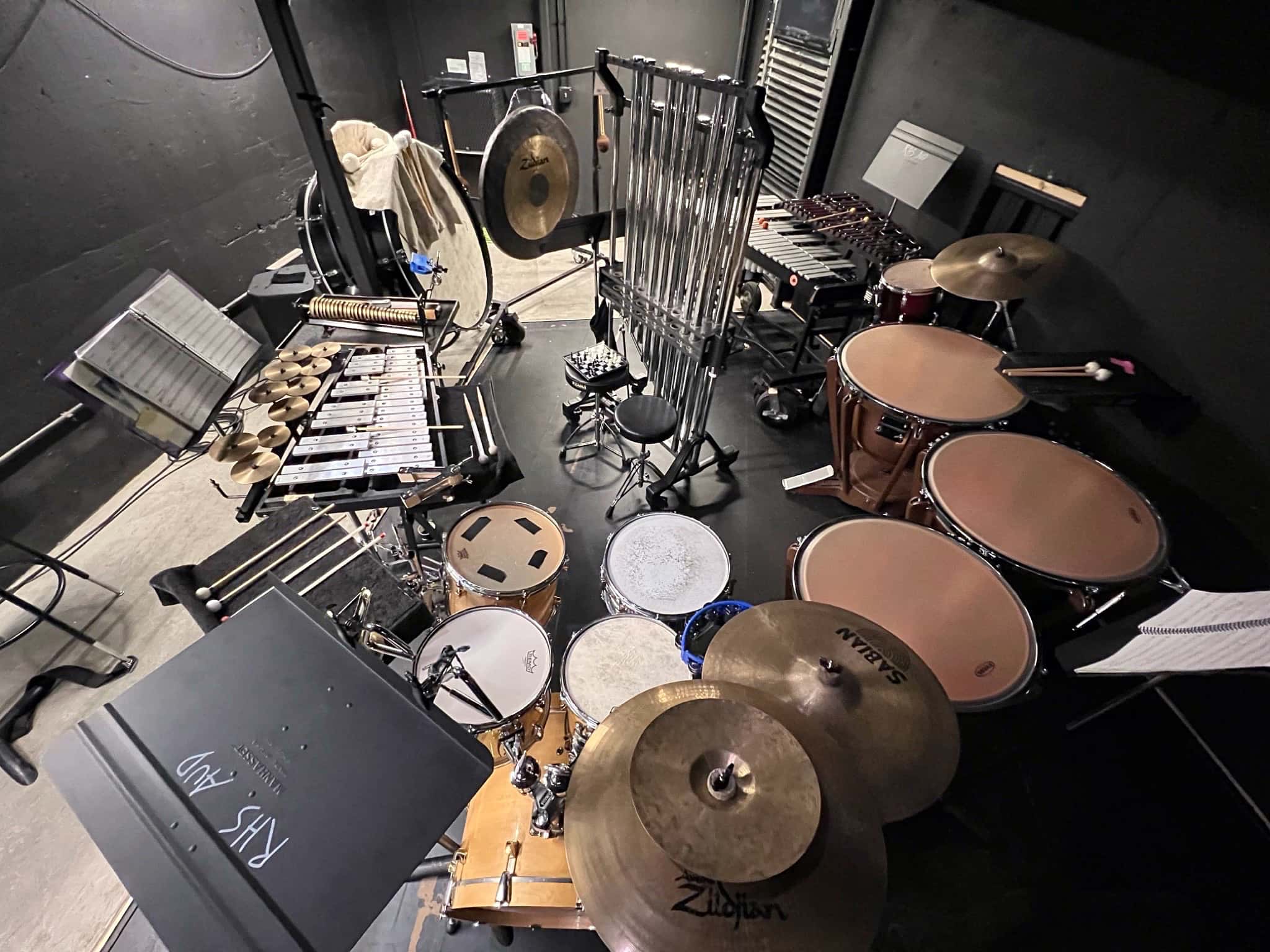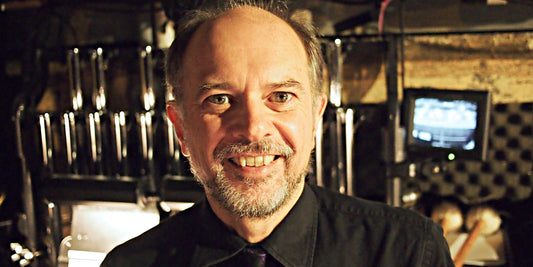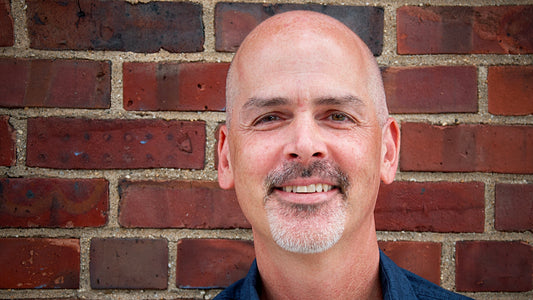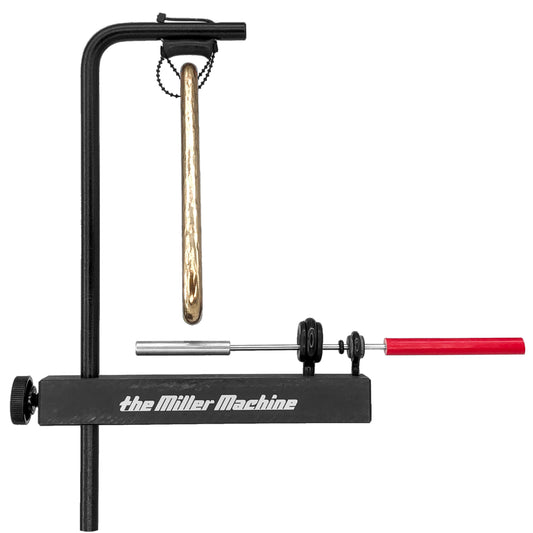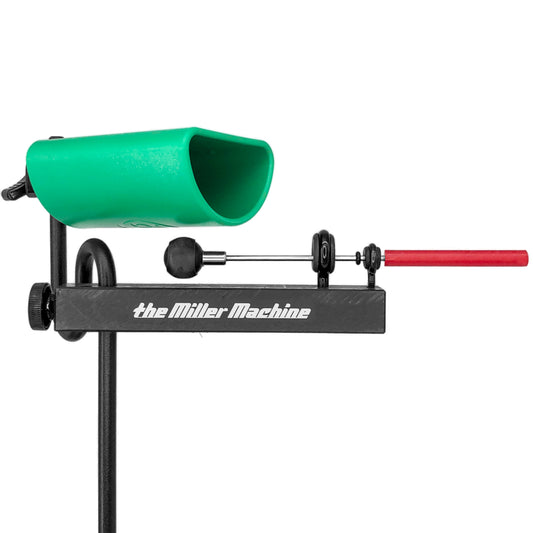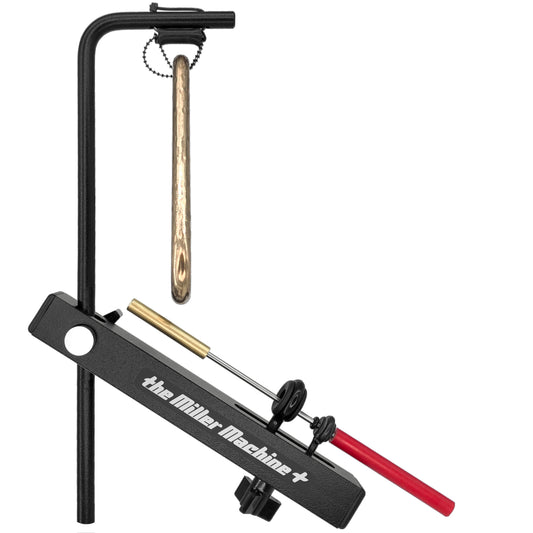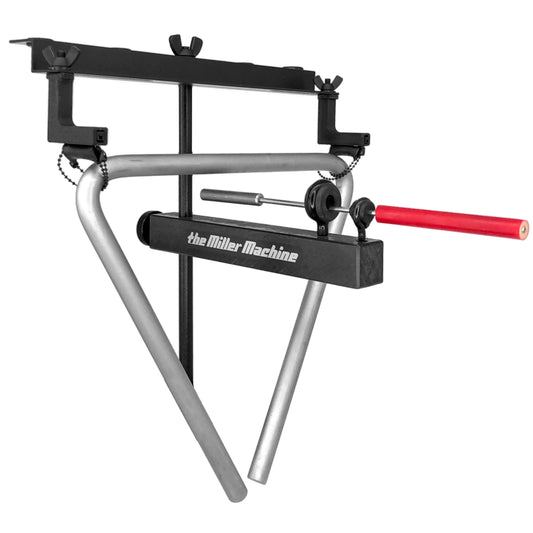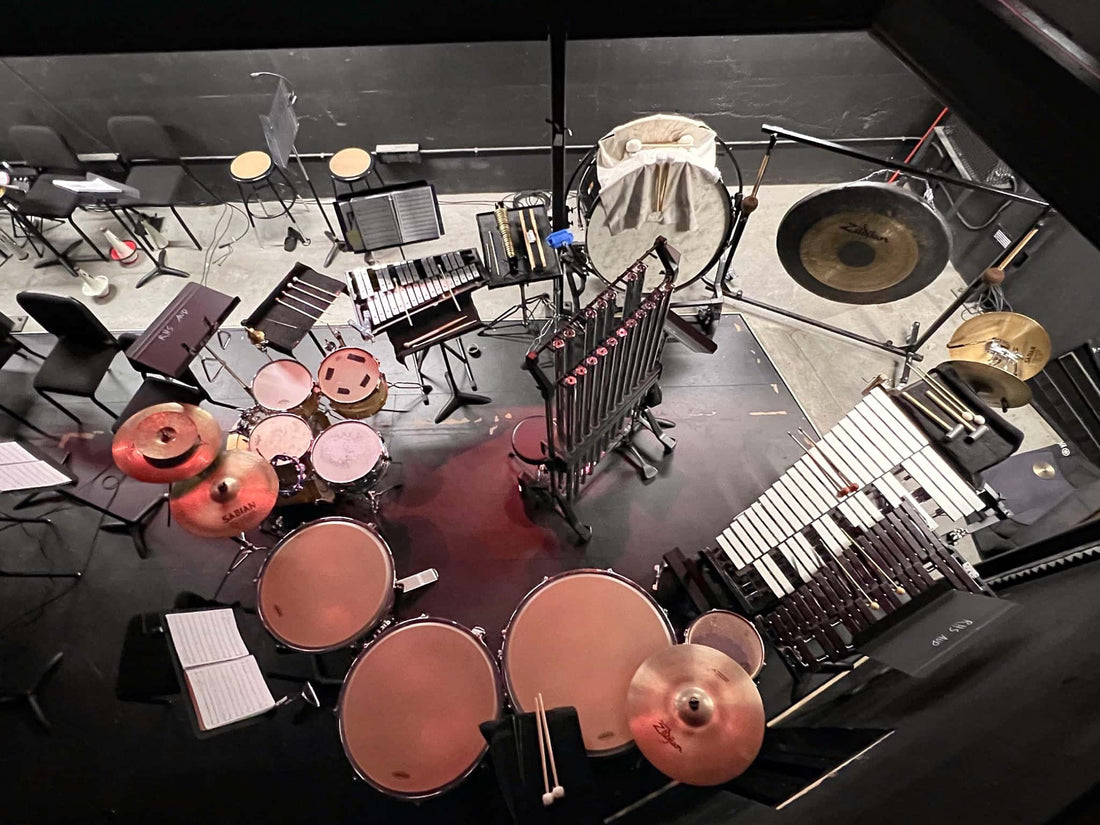
Sweeney Todd - Quinton Perry, Henry Rice
Quinton Perry and Henry Rice's setup for Sweeney Todd at Richland High School, in Richland, Washington.
Gear list and write-up below photos.
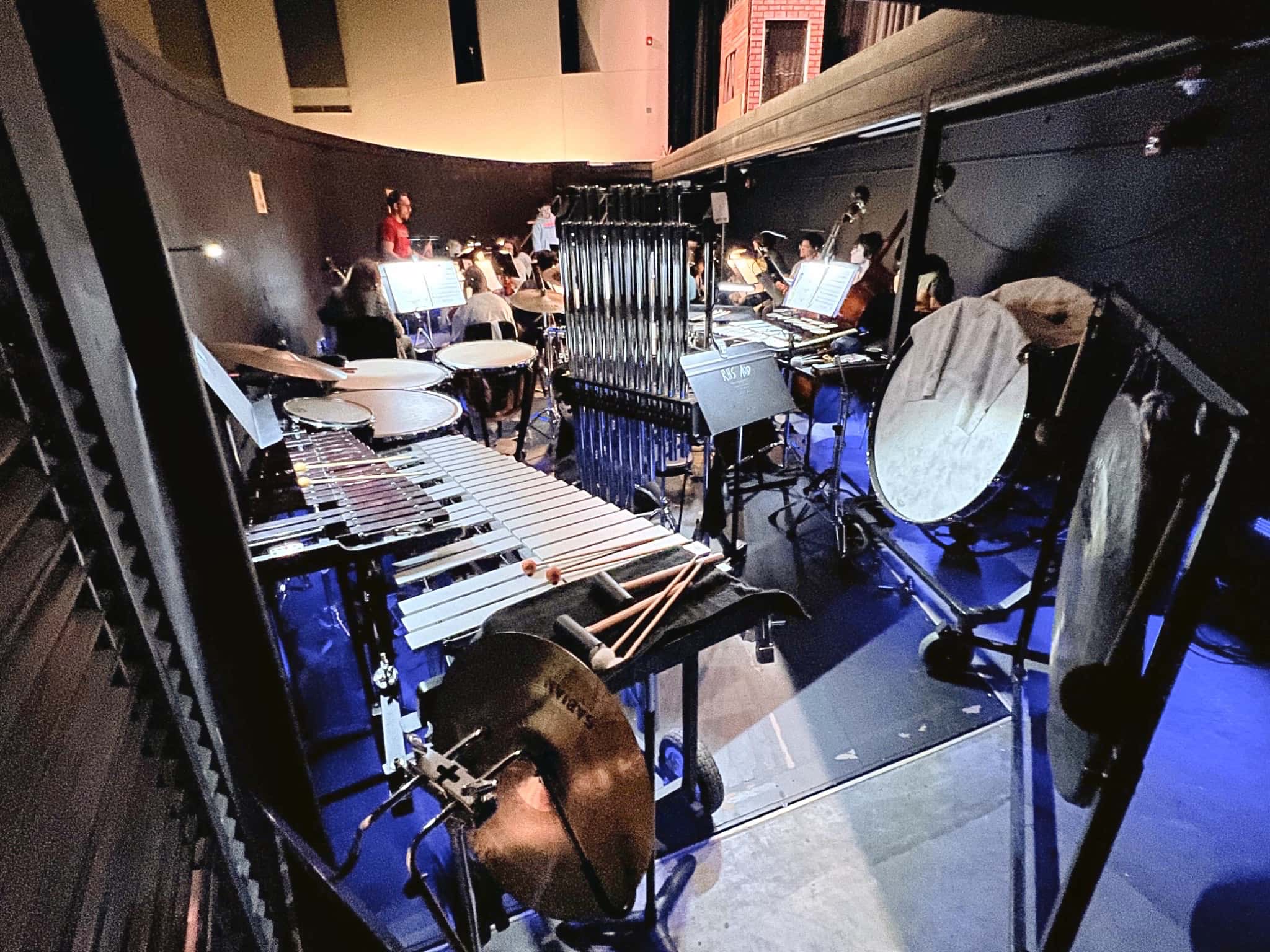
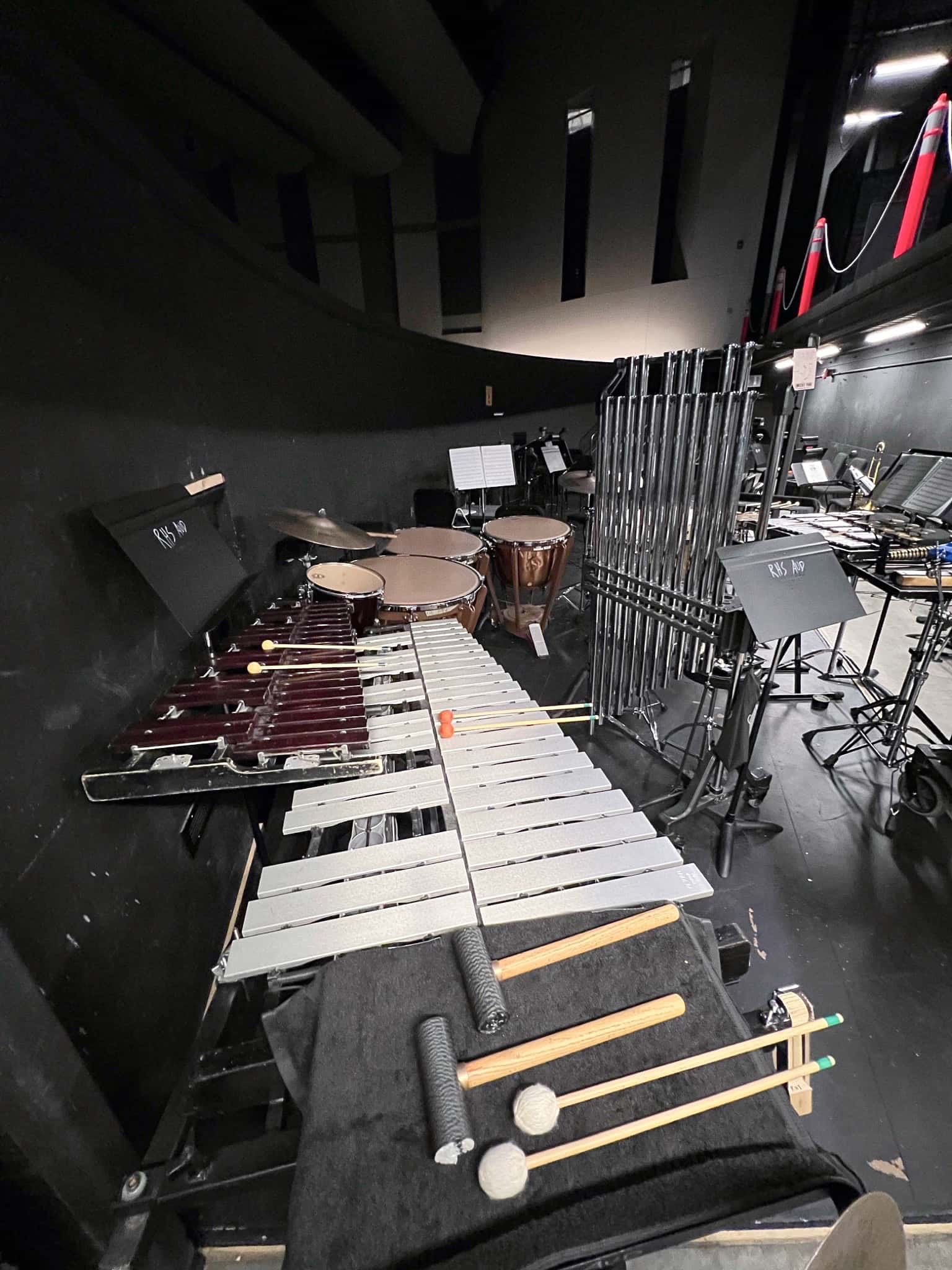
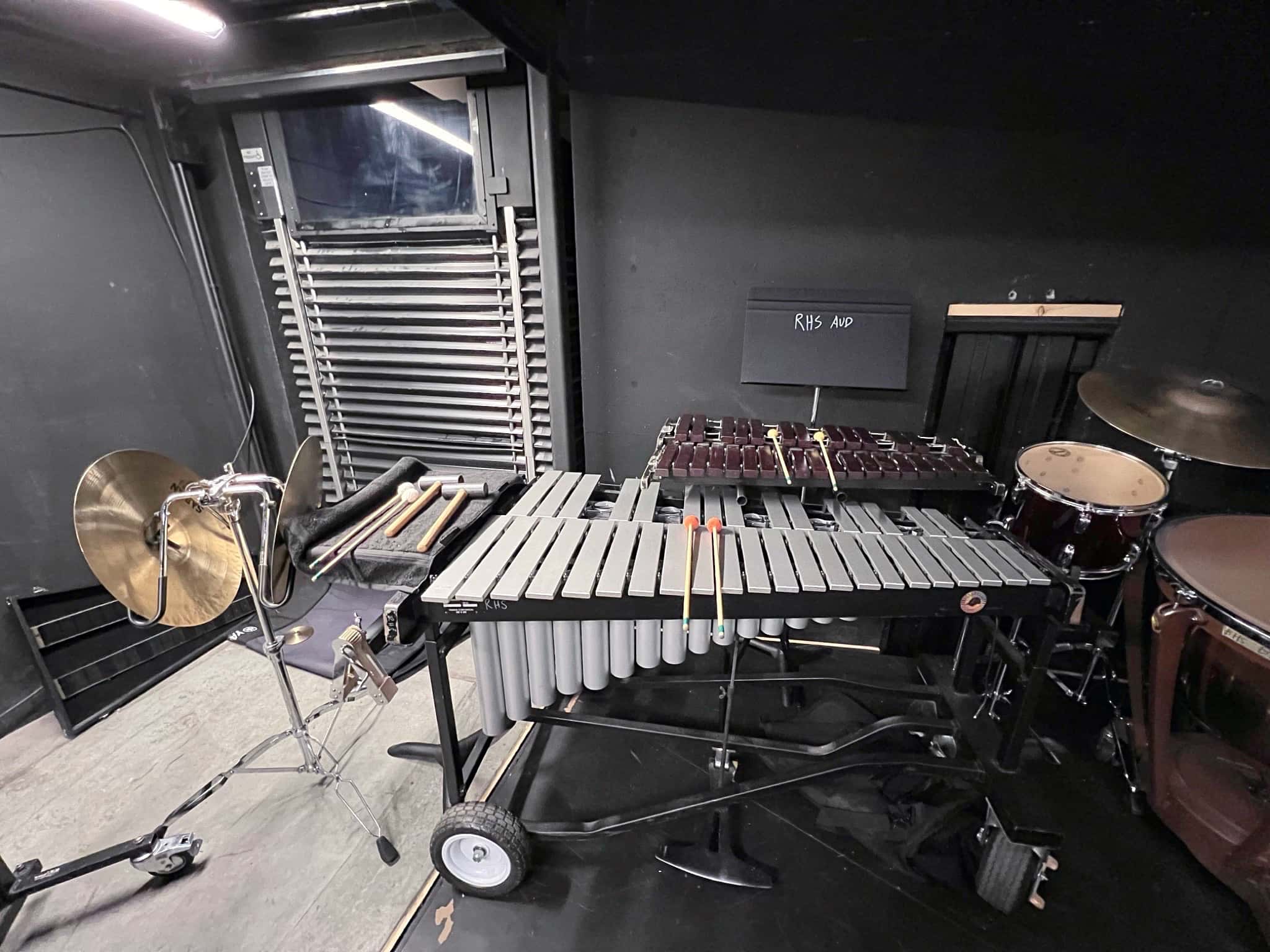
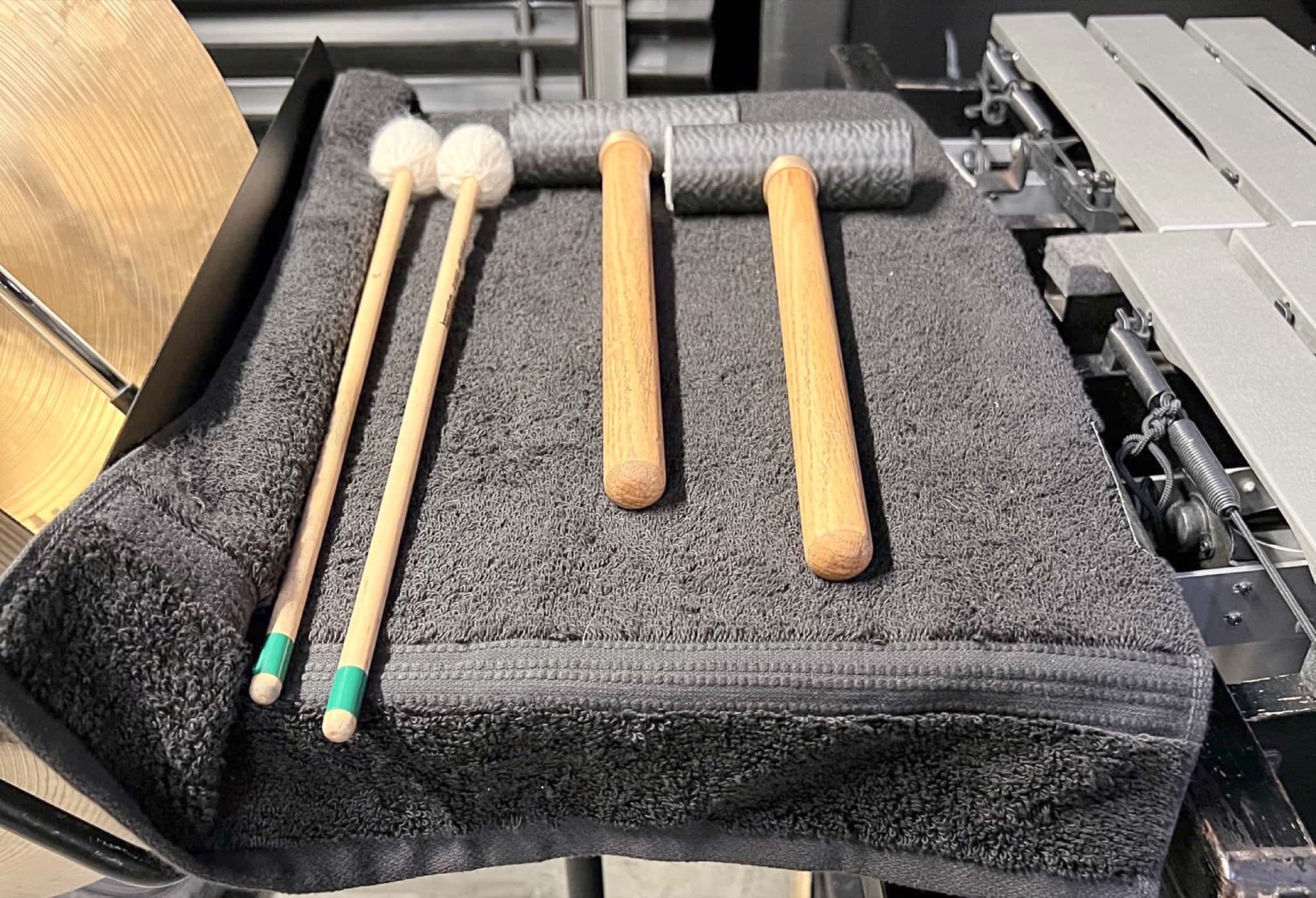
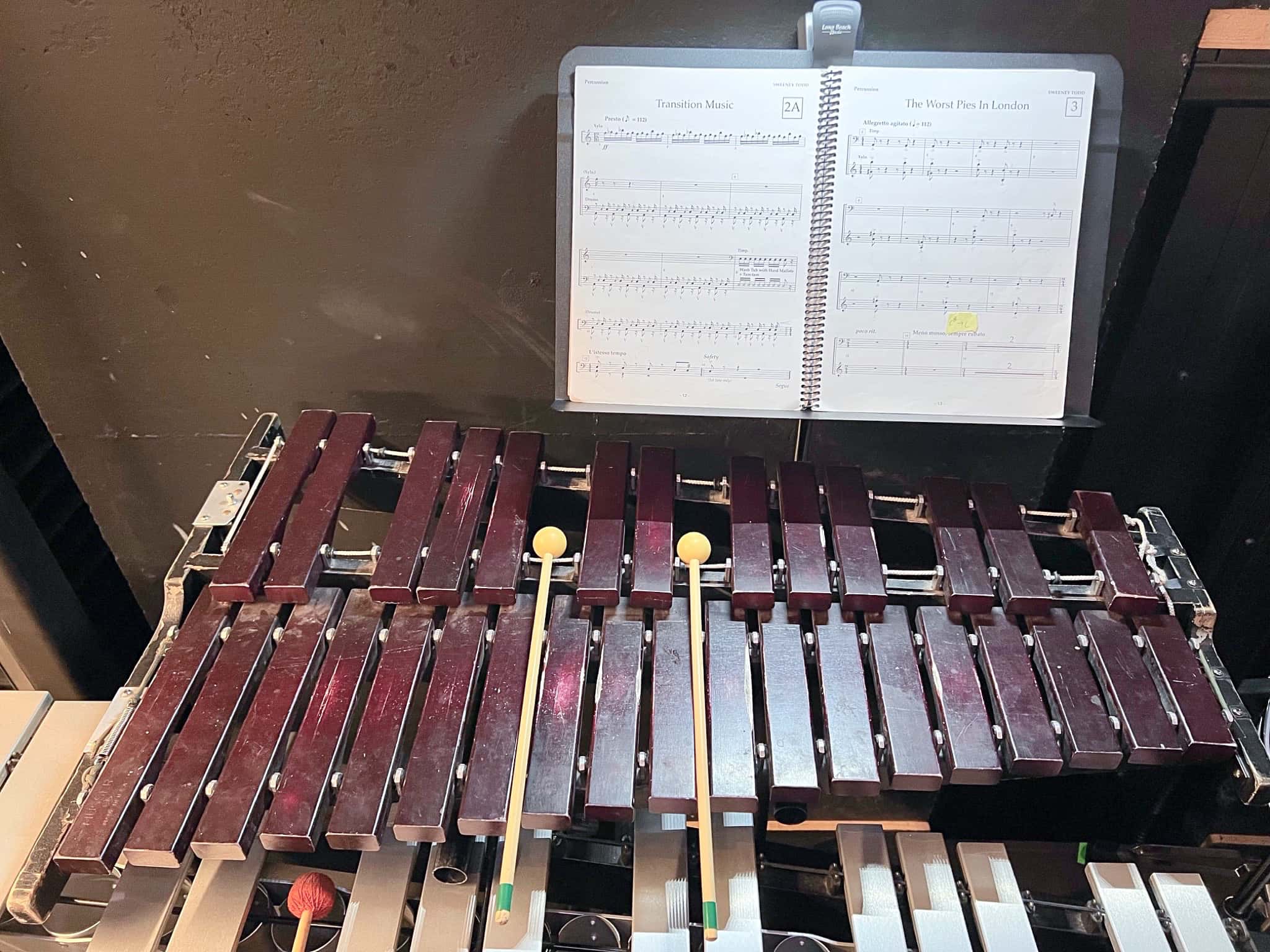
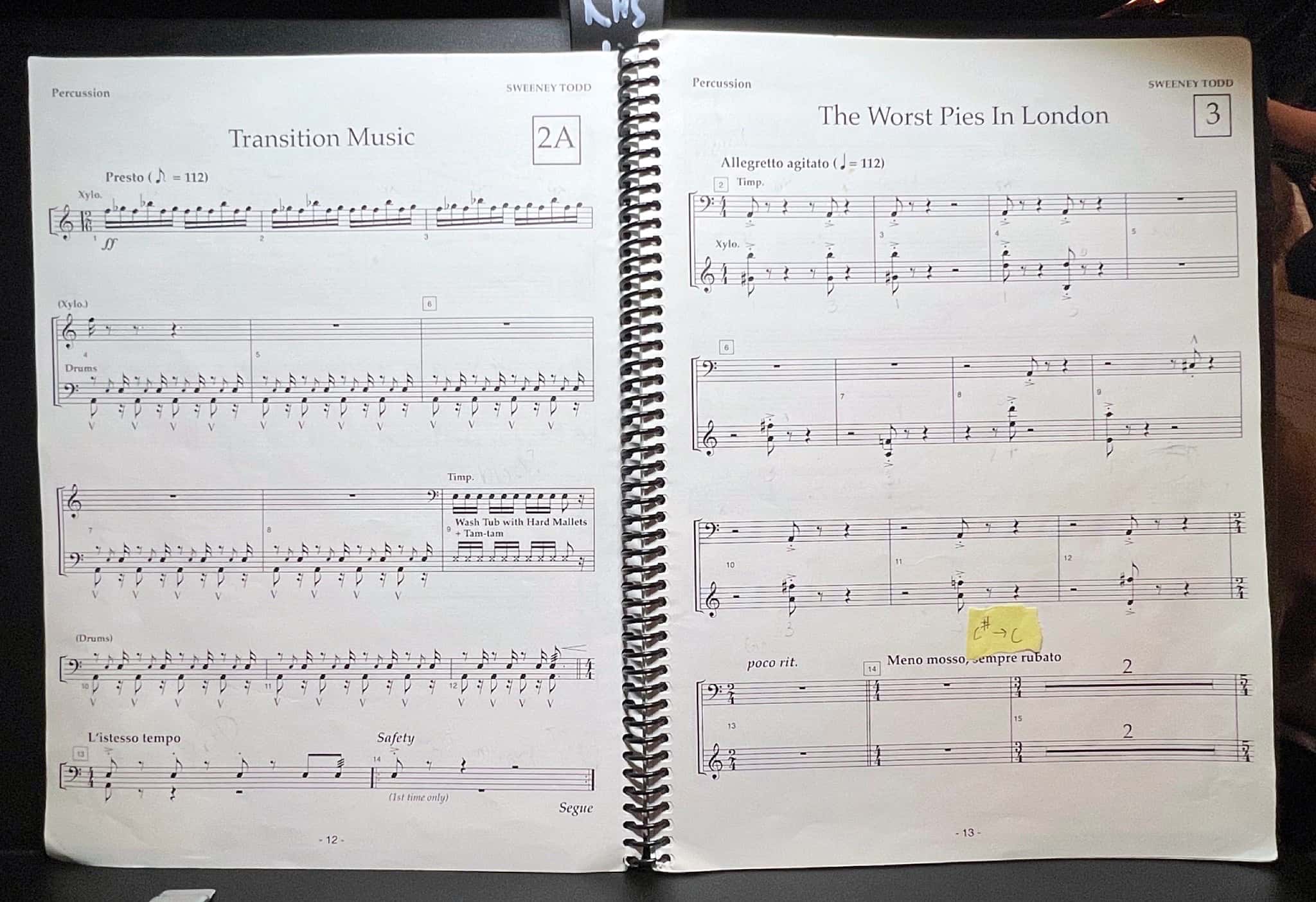
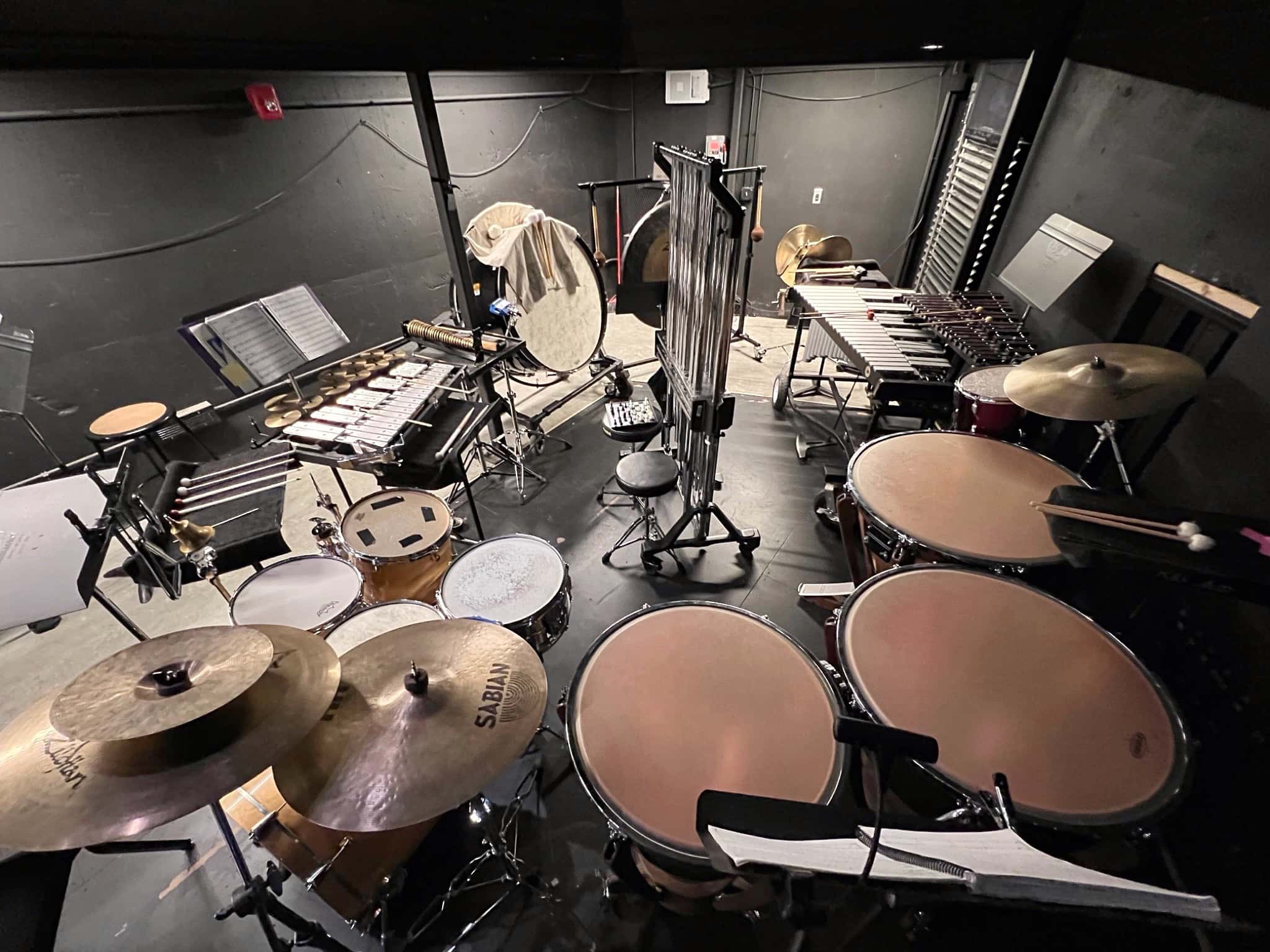


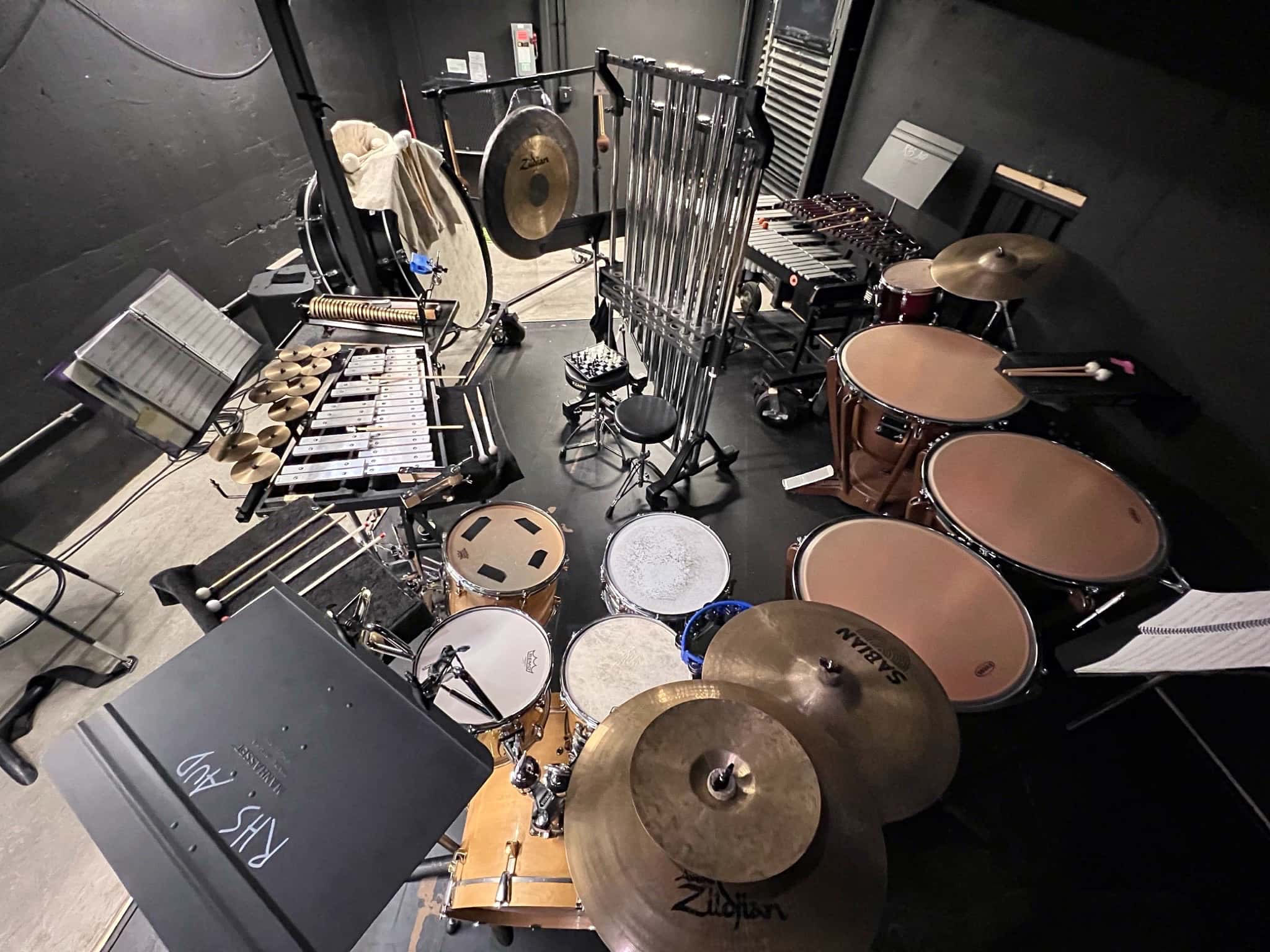
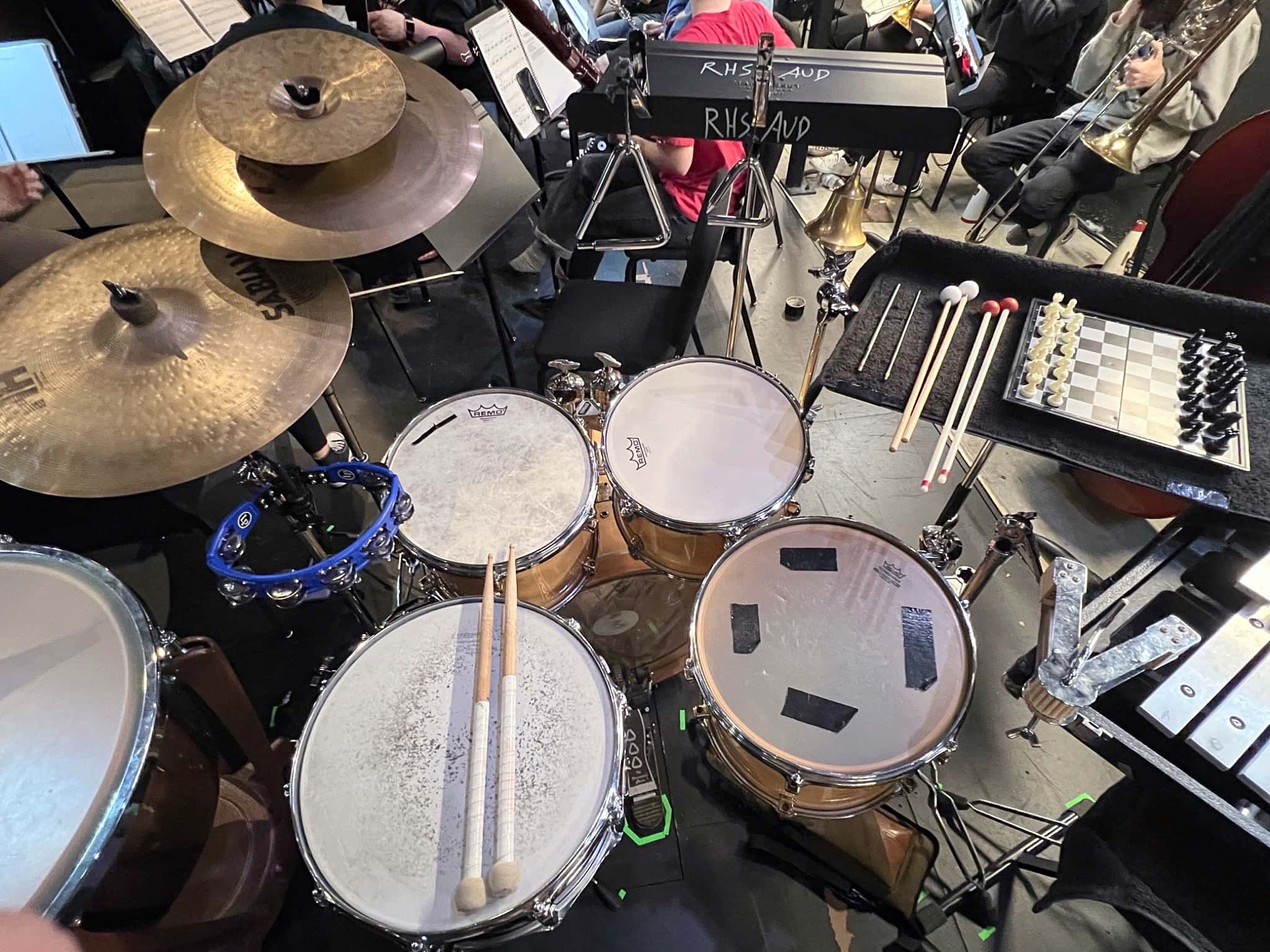
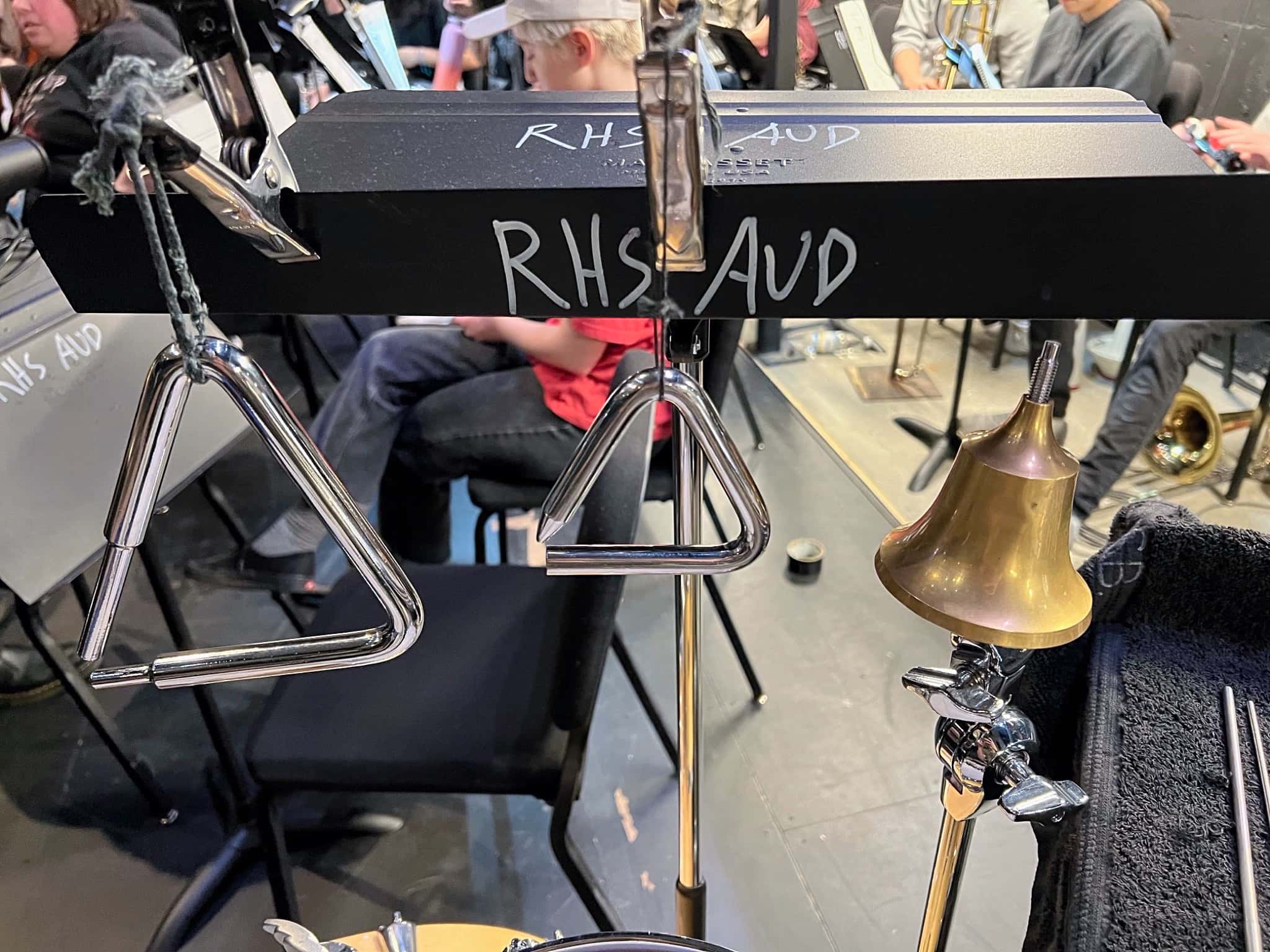
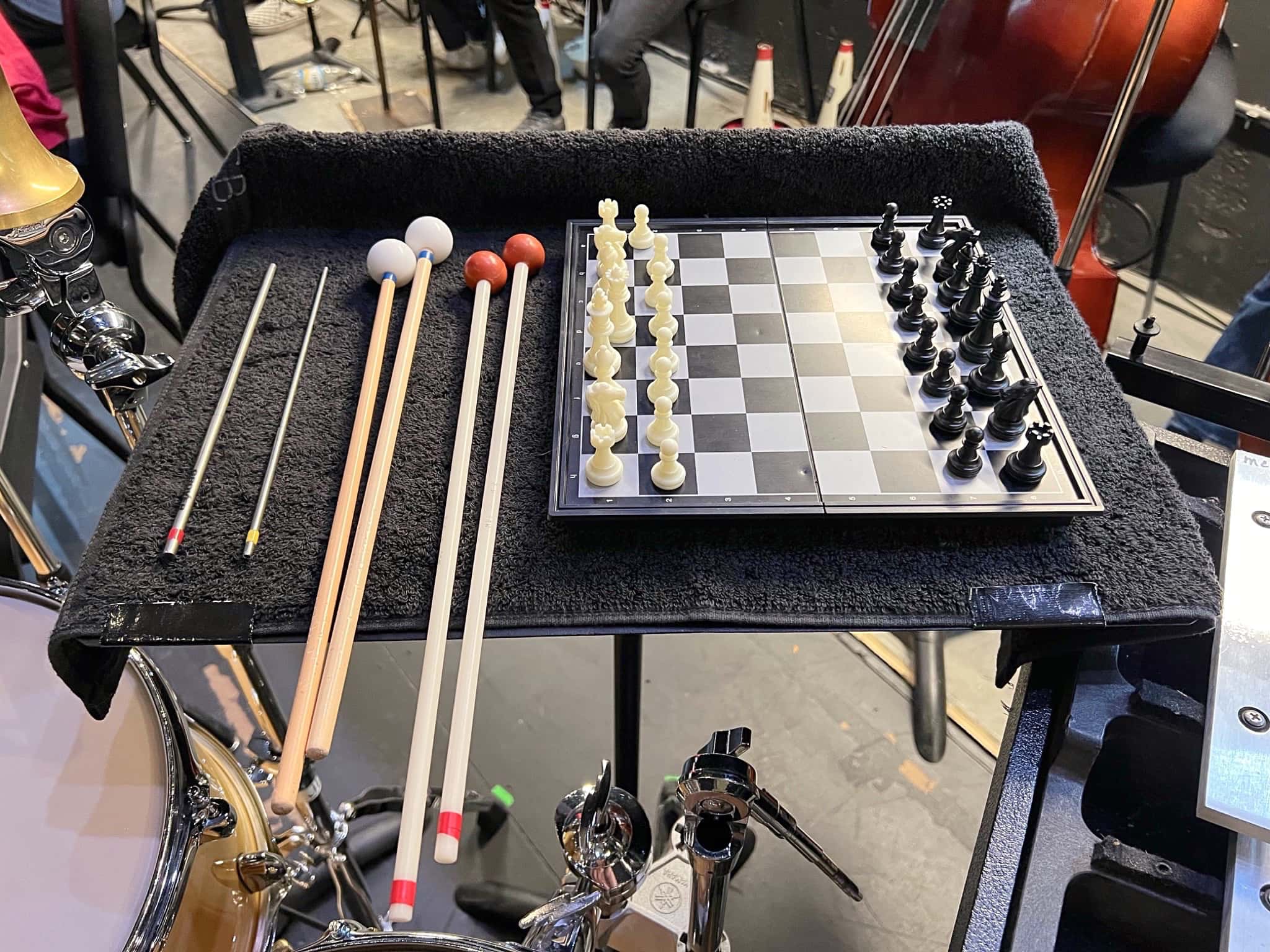


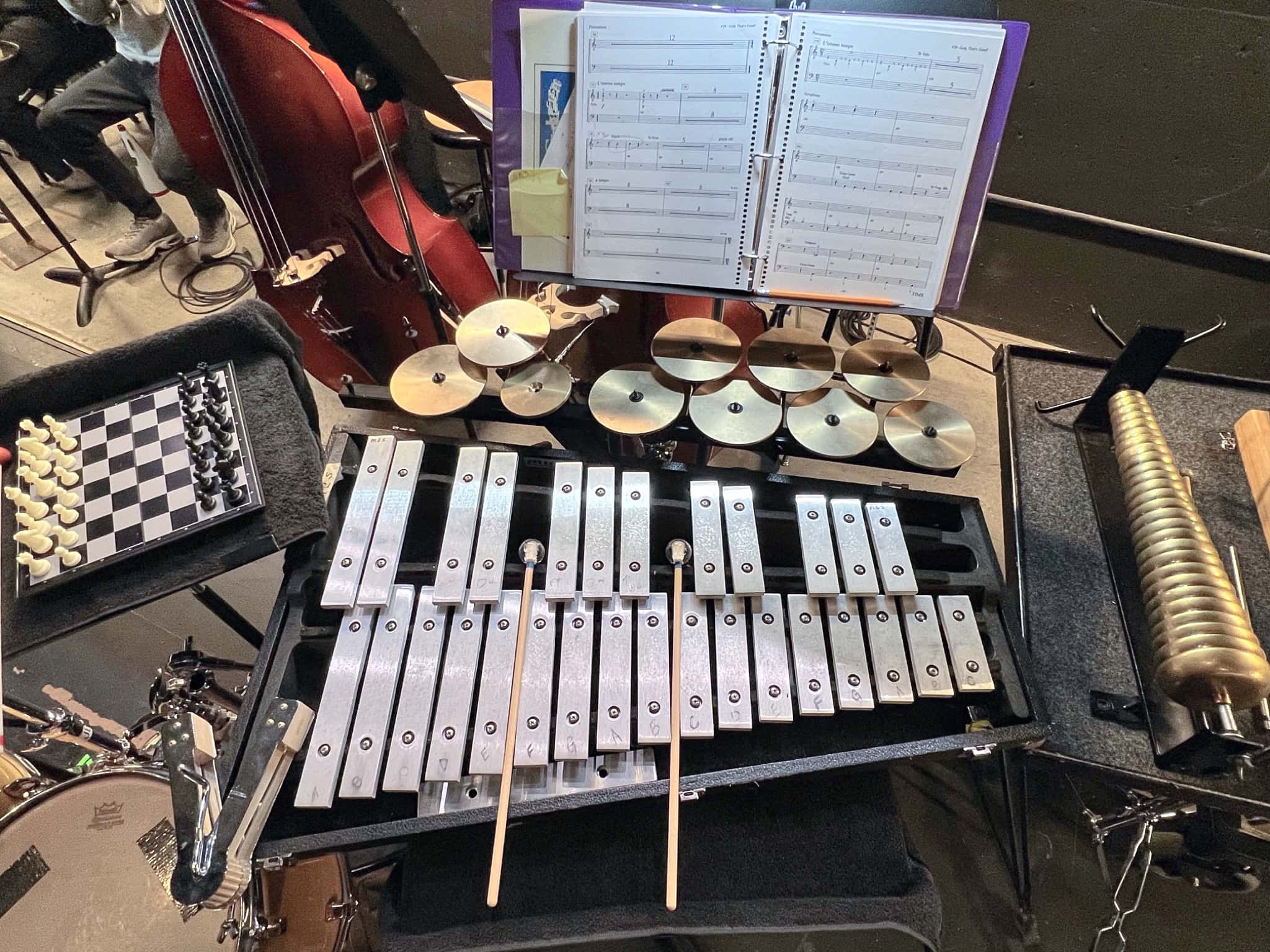
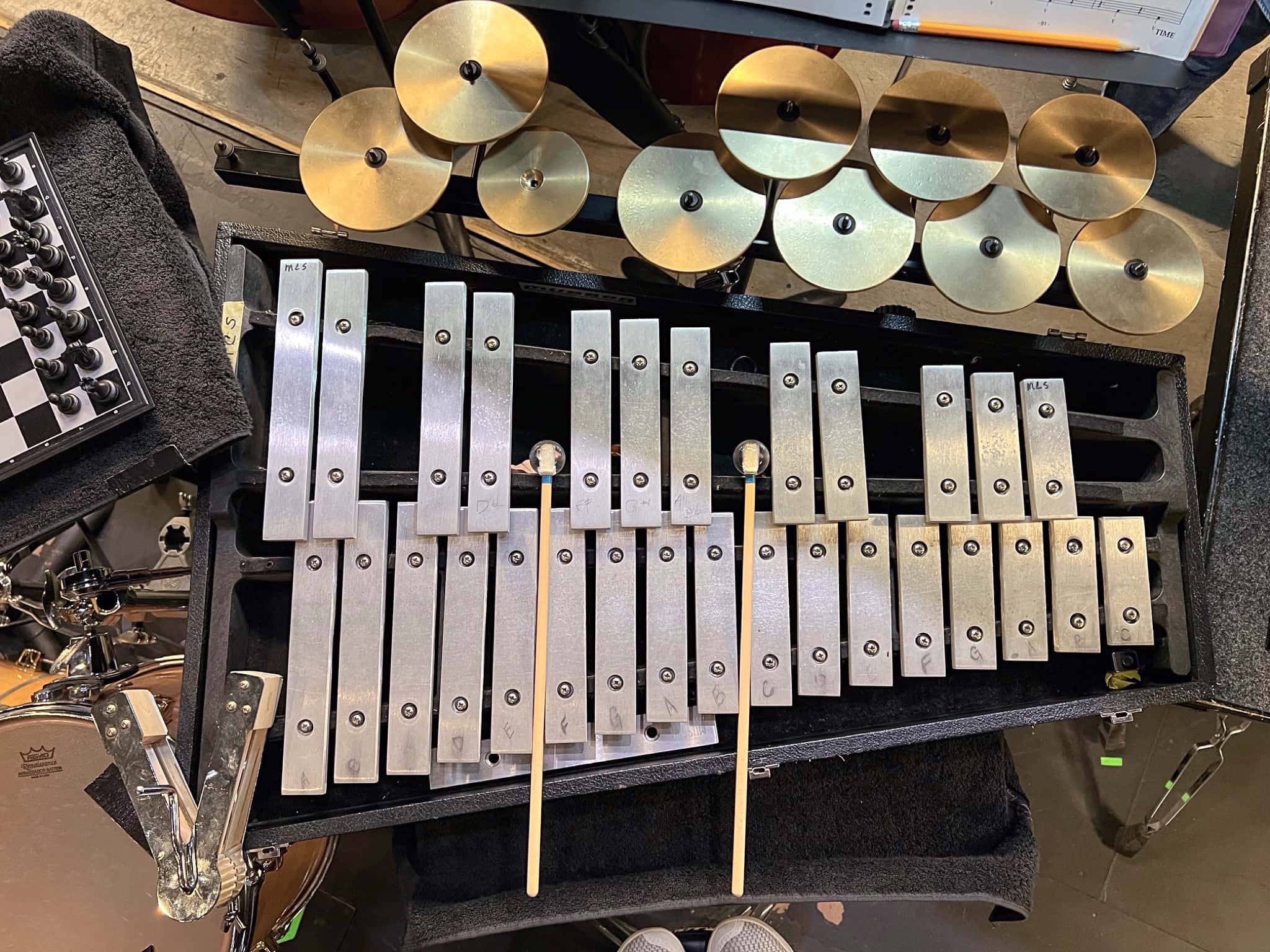

Above: Custom Made Razor Strop, description below.
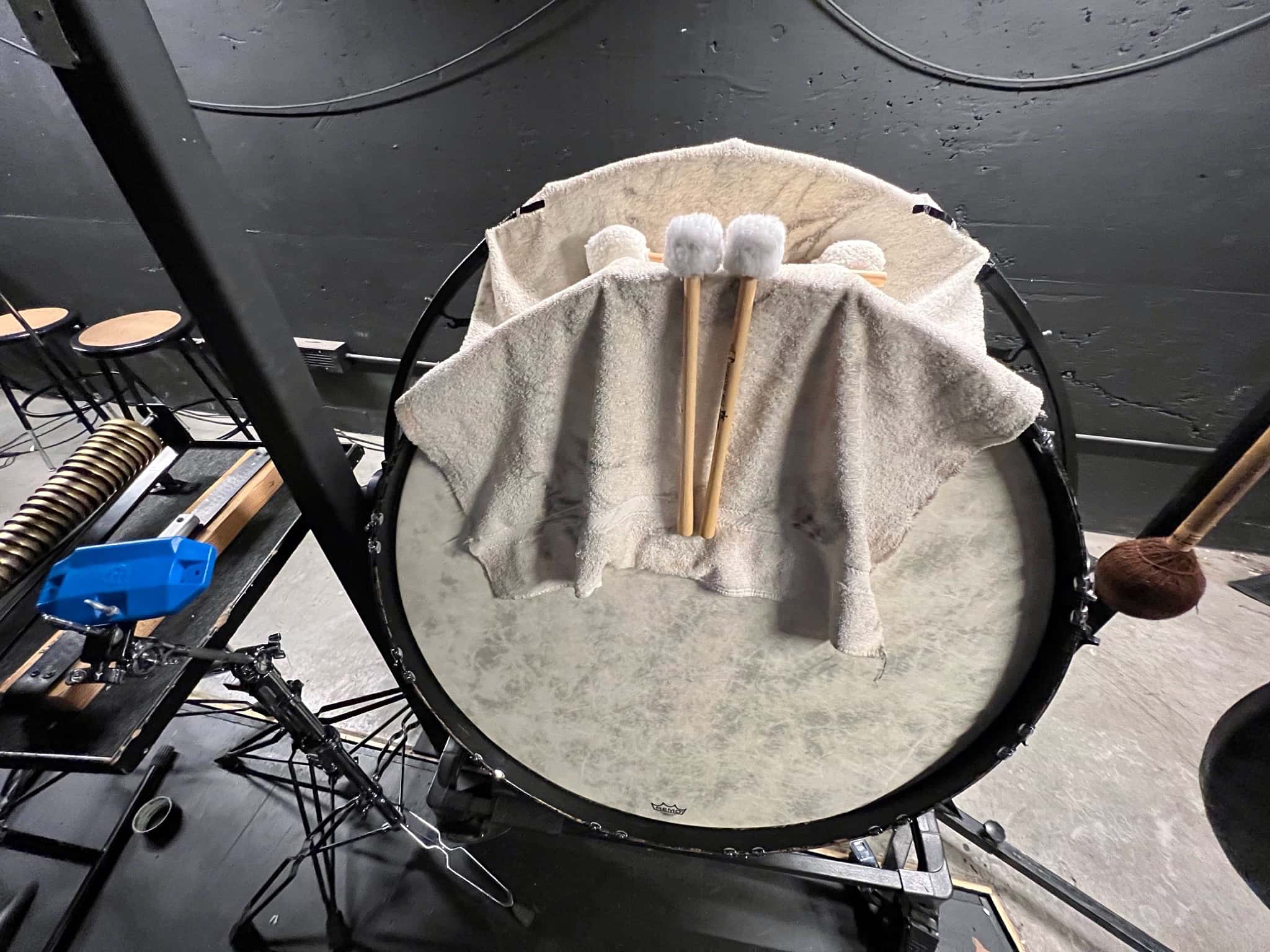
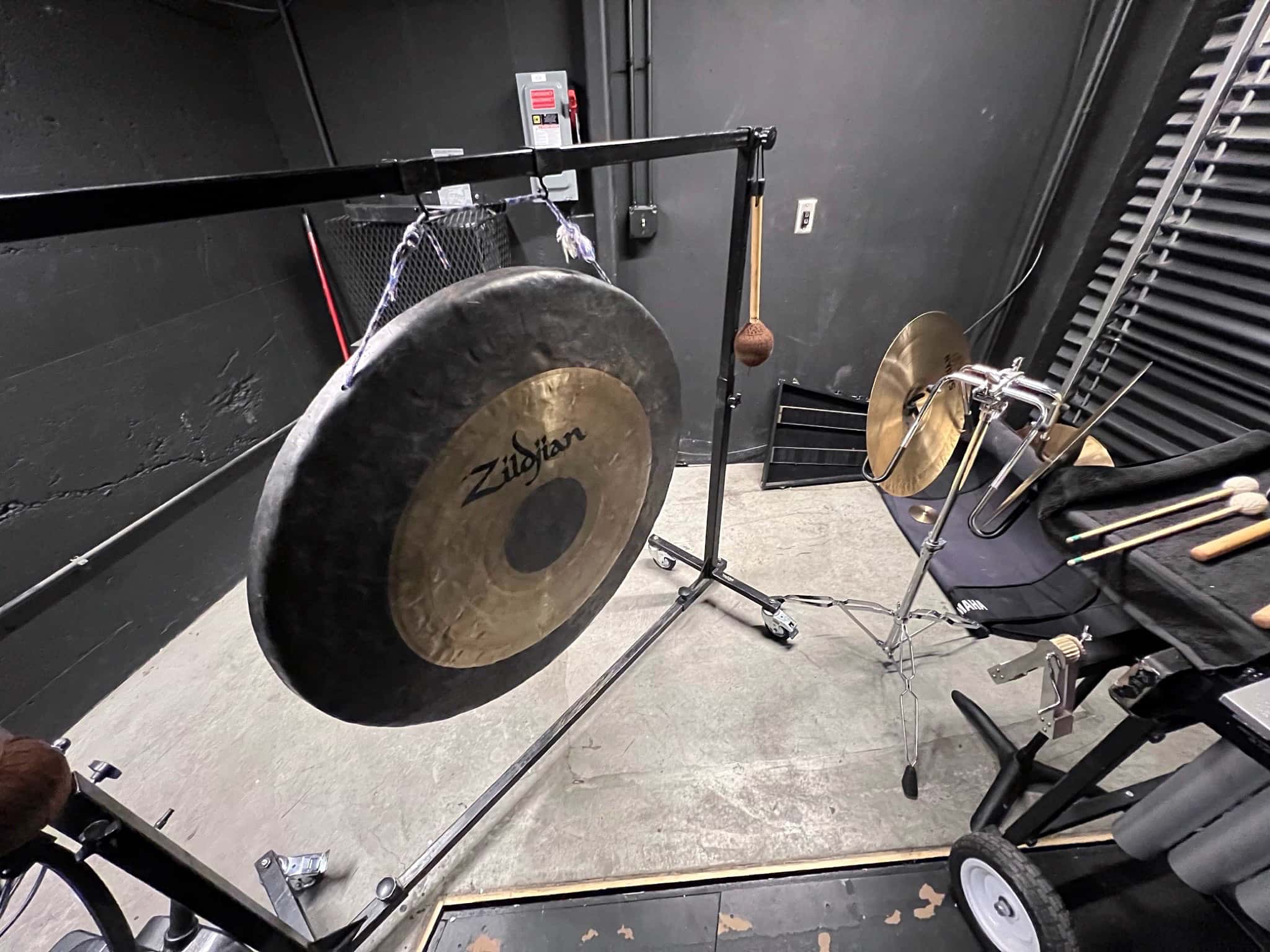
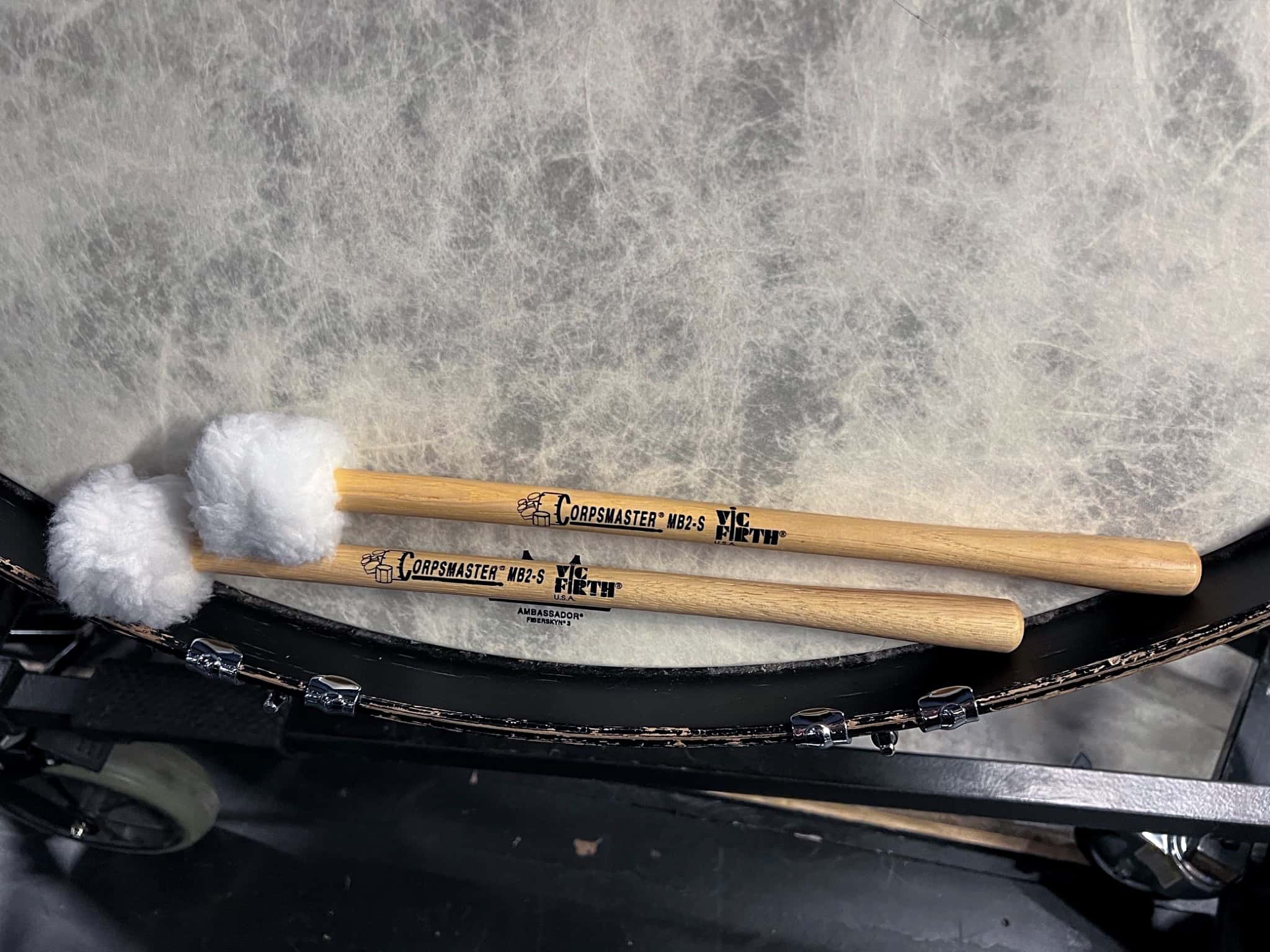
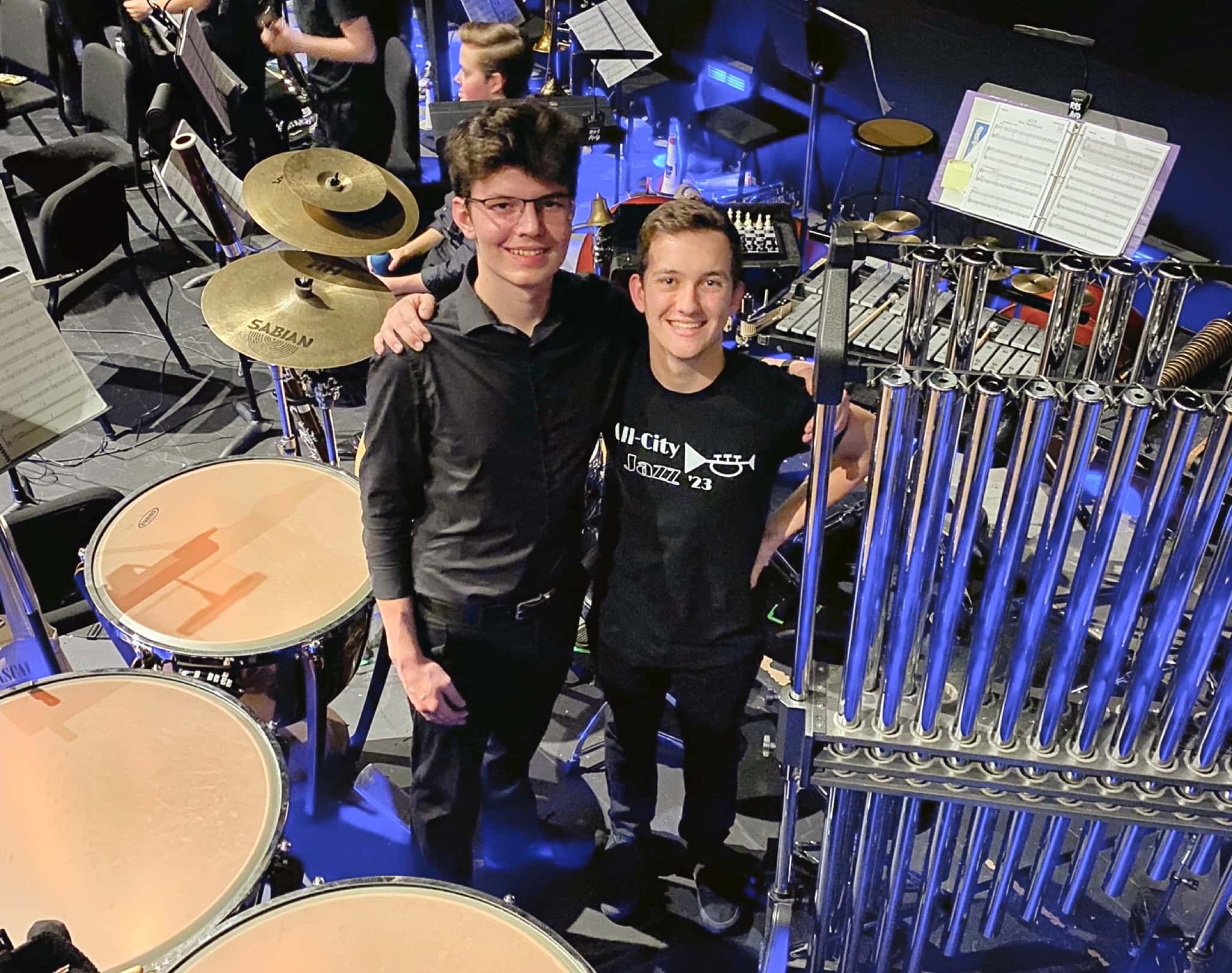 Above: Quinton Perry and Henry Rice
Above: Quinton Perry and Henry Rice
The Setup:
"We got the book for the show, and immediately began researching how to lay out the instruments. I soon found out that multiple different books were out, each requiring their own amount of players. We had the two-person book, so while rehearsing, we would add instruments as they came up in the parts. Basically building as we went, making sure we each could play our own sides without the other person getting in the way.
We had to stack and compact the instruments very tightly and ended up modifying our set up five or six times before our first performance. It was a rough process, and may have seemed a little chaotic to others, but to us, it worked out perfectly. We set up about eight music stands around the setup, acting as a spot for music, or temporary trap tables for mallets.
The pit is a weird shape and we had to make sure that the instruments mostly faced the conductor. The rest of it was built in kind of two halves per se. In the music, the separate parts were written on two lines. I had the line that had the kit and toms, gran casa, woodblock, glockenspiel, crotales, some triangle, the ratchets, and the xylophone. Henry had the timpani, vibraphone, chimes, some triangle, and the xylophone as well.
Originally, the LP Jam Block was mounted to the drum kit when I had to use it in 'God That’s Good' and in the practice space before the show, the layout of the percussion was a tad different than the final version. This was due to that annoying pole that ended up separating the bass drum and glockenspiel down in the pit. In practice, I was able to easily hit the Jam Block and bass drum with each hand easily. But once we made it down to the pit, the separation wasn’t as easy to work with. I found a spare cymbal stand and rigged up the Jam Block in a way that I wouldn’t have to change grips when playing it. Ultimately, facing backwards in that weird position was easiest because it was right in striking distance and the angle worked to get the best sound.
It was especially difficult getting the chimes in a spot that would work. Because the chimes we used are much taller than normal ones (and in the book the chimes part had special cues with timing) and we needed to see what we were playing, and the conductor. We assumed that the middle of our little circle would be the best spot. It was kind of hard trying to figure out how to place everything around the chimes, but it worked out in the end once we got in the pit.
We had a very good time down in the pit, playing with each other and interacting with our parts. Although we had some very interesting close calls with trying to run around the other person to get into our parts in time, we put on a great performance every night.
One of the most difficult pieces to get right every night was 'God That’s Good'. It required me to access the entire drum kit, the gran casa, wood block, ratchet, glockenspiel, and the little ‘swiss bell’. The gran casa was just a normal concert bass drum, and it needed to be near the gong, but the glockenspiel needed to be right by the drum kit for quick changes. I ended up taking all of these and making up my half of the circle, but it was very stressful running back and forth in between the parts with multiple mallets in my hands at times, all needing access to one book that was in front by the glockenspiel.
The crotales were an instrument we originally weren't going to use due to space in the pit and I assumed we would play those parts on the glockenspiel. However, we decided to try and make it work. The best spot honestly seemed to be stacking it with the glockenspiel because I had the same mallets in my hands, and the music was right there. It ended up working amazingly, even though we didn’t have a low C crotale, and the stacking was a great choice in the end.
The music called for a triangle, a smaller triangle, and the smallest triangle. So, with my part being the one with those different sized triangles, we lined up the small triangle, and the smallest triangle on the music stand right next to the makeshift swiss bell. Having all three of those in a line was really nice because the beaters were very close and it was easy to switch triangles when we needed.
Strange Instruments:
Razor Strop
We looked at the part and noticed that a razor strop might be needed. None of the members of the pit, or I, had ever used a straight razor, so I ended up going to the local thrift shop and buying a cheap leather belt. I then took a wood 2x4 and screwed the belt to the wood. Then, using a pocket knife, I made the sound effect needed for the show by scraping the pocket knife across the belt on the wood. It was difficult trying to get a loud noise, but for the most part it worked out pretty well.
Whistle
Another weird instrument we needed was a whistle. I did some research and found out the actual show used a steam locomotive train whistle. A very high-pitched, shrill noise, that 'needed to fill the theatre with a chilling scream'. We didn’t have access to one, or the money, so I ended up digging around my house and found a little plastic whistle from a first aid kit. I took the little ball inside the whistle out, and boy was that thing loud. I had to wear ear protection when playing it in the pit, and from the audience and actors, they said it definitely filled that role.
Swiss Bell
About three weeks into rehearsals, one instrument came into the part that I had overlooked. In 'God That’s Good', a swiss bell was needed for just three hits. We didn’t have one, so I went back to that thrift shop and found an old hand bell. I took the handle apart, and re-threaded the inside of the bell to fit the threads of a normal cymbal stand. It sounded like what we needed and it worked pretty well. I now have a little bell I can add to my drum kit and it has a nice sound to it.
Chess Board:
Down in the pit, life can get a bit boring especially when you don’t play for four songs. The other percussionist and I thought it would be fun to bring down a Chess board and sharpen up our skills. Once we got comfortable with the show, we played every second we could. I ended up getting destroyed and lost 8 games to 3. However, there were some close calls where I almost dropped a piece on the pit floor, which could’ve lead to some disturbances during the show. It was a fun little addition to the setup and fit nicely on the trap table.
Overall, the show was such a challenge, but in a good way. The controlled chaos and fantastic music really was something different than other shows I’ve done before.
Stay away from Fleet Street!"
Drum Kit:
- Bass Drum
- Snare Drum
- Small Tom
- Medium Tom
- Floor Tom
[side note for drum kit. One instrument we didn’t have was the top of a metal trash can. It was written in the part so I ended up hitting a music stand and it produced the same metal trashy sound we needed for the show. I ended up attending the Broadway performance in New York City and they did have a metal trash can lid attached to the drum kit, which was fun to see.]
Cymbals:
- Crash Cymbal
- Splash Cymbal
Percussion:
- Timpani (we used three which required more tuning changes, four would be ideal)
- Vibraphone
- Xylophone (small 2-3 octaves work good)
- Glockenspiel
- Crotales (one octave)
- Chimes
- Gran Casa (aka really big bass drum)
- Tam Tam
- Triangle/Smaller Triangle/Smallest Triangle
- Tom Drum
- Suspended Cymbals (2)
- Piatti
- LP Jam Block
- Razor Strop (custom made)
- Bell Tree
- Tamborine
- Swiss Bell (or any kind of bell)
- Whistle (must be LOUD, and piercing)
- Ratchet(s)
[side note for ratchets: we used two ratchets mounted to random parts of the setup because the music requires very quick moves and they had to be close to the instrument you play beforehand—two was best in our findings with the two person book we had.]
Sweeney Todd - Regional - Quinton Perry, Henry Rice
February 2024
